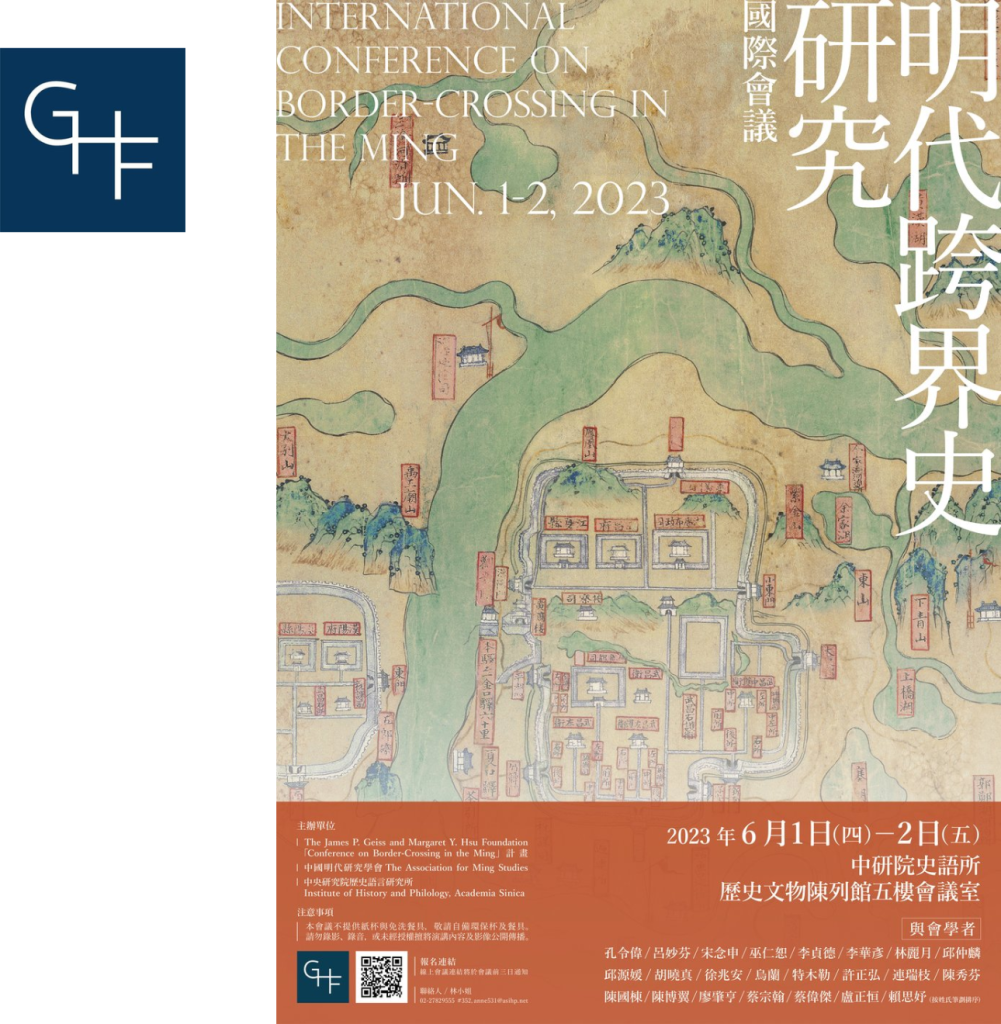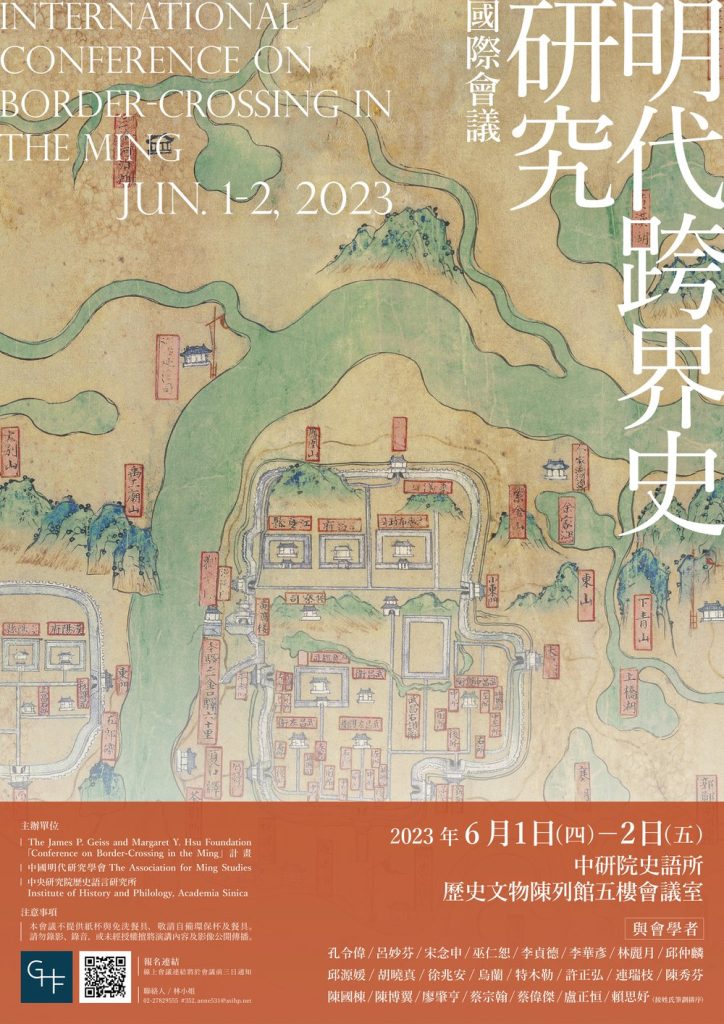明代跨界史研究國際會議
2023 International Conference on
Border-Crossing in the Ming
時間/Time:
2023年6月1-2日 上午10:00-下午5:00
Jun. 1-2,10:00-17:00 ,2023
地點/Venue:
中央研究院歷史語言研究所 歷史文物陳列館五樓會議室(臺北市南港區研究院路二段130號 )
5F Conference Room, Museum of the Institute of History & Philology, IHP, Academia Sinica
會議語言:華語、英語
報名截止日期:2023. 5. 29
主辦單位/ Organizers:
1. The James P. Geiss and Margaret Y. Hsu Foundation
「A Conference on Border-Crossing in the Ming」計畫
2. The Association for Ming Studies 中國明代研究學會
3. Institute of History and Philology, Academia Sinica 中央研究院歷史語言研究所

明代跨界史研究國際會議
2023 International Conference on
Border-Crossing in the Ming

時間/Time:
2023年6月1-2日 上午10:00-下午5:00
Jun. 1-2,10:00-17:00 ,2023
地點/Venue:
中央研究院歷史語言研究所 歷史文物陳列館五樓會議室(臺北市南港區研究院路二段130號 )
5F Conference Room, Museum of the Institute of History & Philology, IHP, Academia Sinica
會議語言:華語、英語
報名截止日期:2023. 5. 29
主辦單位/ Organizers:
1. The James P. Geiss and Margaret Y. Hsu Foundation
「A Conference on Border-Crossing in the Ming」計畫
2. The Association for Ming Studies 中國明代研究學會
3. Institute of History and Philology, Academia Sinica 中央研究院歷史語言研究所

會議簡介
Since the turn of the new millennium, historical studies of the Qing’s expansion into these geographic areas have generated refreshing perspectives on how a China-based power interacted with these culturally diverse regions. Many participating scholars have done extensive research on the succeeding Qing empire and positioned the Qing within larger geographic areas with which the Qing interacted, including Inner Asia, the Himalayas, and Central Eurasia.
An emerging consensus among us is that an exclusive focus on the Qing’s negotiation with adjacent communities often draws attention to the historical rupture between a defensive Ming and expansive Qing. This prevailing historical narrative has two problems: first, it renders both the Ming and the Qing historically distinct and static, but each polity ruled China for nearly three centuries, during which territorial reaches changed and policies altered toward their respective neighbors. This conventional dynastic divide of 1644 does a disservice to historical interpretations of both the Ming and the Qing. Second, “border-crossing” is a frequent theme in the history of both Ming and Qing, but their geographical foci differ generally. Studies of the Ming’s global engagement tend to stress its southern littoral regions and sea voyages. The same theme in Qing historiography draws more attention to the Qing’s landmass neighbors in the north, west, or southwest, with a few notable exceptions.
The conference hopes to bring together scholars interested in rethinking their temporal and/or geographical agendas for ongoing or new projects. We aim to reexamine historical changes between the fifteenth and eighteenth centuries in order to extend the so-called “Ming-Qing transition” period. Literary and economic histories of late imperial China have long advocated reconsidering the dynastic division in research and generated productive conversations in their respective fields of inquiry. We hope to underscore both historical continuity and changes between Ming and Qing China in their interactions with neighboring communities.
Methodologically, the workshop brings animal studies, material culture, and global history into historical discussions of late imperial China. How did ideas, people, things, and animals cross borders? How did the Ming and later Qing states understand these movements? What had changed and continued in the extended period of political transition? Answers to these questions will facilitate new interpretations of the Ming and foster greater collaboration among historians in late imperial China, including both the Ming and the Qing.

會議簡介
Since the turn of the new millennium, historical studies of the Qing’s expansion into these geographic areas have generated refreshing perspectives on how a China-based power interacted with these culturally diverse regions. Many participating scholars have done extensive research on the succeeding Qing empire and positioned the Qing within larger geographic areas with which the Qing interacted, including Inner Asia, the Himalayas, and Central Eurasia.
An emerging consensus among us is that an exclusive focus on the Qing’s negotiation with adjacent communities often draws attention to the historical rupture between a defensive Ming and expansive Qing. This prevailing historical narrative has two problems: first, it renders both the Ming and the Qing historically distinct and static, but each polity ruled China for nearly three centuries, during which territorial reaches changed and policies altered toward their respective neighbors. This conventional dynastic divide of 1644 does a disservice to historical interpretations of both the Ming and the Qing. Second, “border-crossing” is a frequent theme in the history of both Ming and Qing, but their geographical foci differ generally. Studies of the Ming’s global engagement tend to stress its southern littoral regions and sea voyages. The same theme in Qing historiography draws more attention to the Qing’s landmass neighbors in the north, west, or southwest, with a few notable exceptions.
The conference hopes to bring together scholars interested in rethinking their temporal and/or geographical agendas for ongoing or new projects. We aim to reexamine historical changes between the fifteenth and eighteenth centuries in order to extend the so-called “Ming-Qing transition” period. Literary and economic histories of late imperial China have long advocated reconsidering the dynastic division in research and generated productive conversations in their respective fields of inquiry. We hope to underscore both historical continuity and changes between Ming and Qing China in their interactions with neighboring communities.
Methodologically, the workshop brings animal studies, material culture, and global history into historical discussions of late imperial China. How did ideas, people, things, and animals cross borders? How did the Ming and later Qing states understand these movements? What had changed and continued in the extended period of political transition? Answers to these questions will facilitate new interpretations of the Ming and foster greater collaboration among historians in late imperial China, including both the Ming and the Qing.
